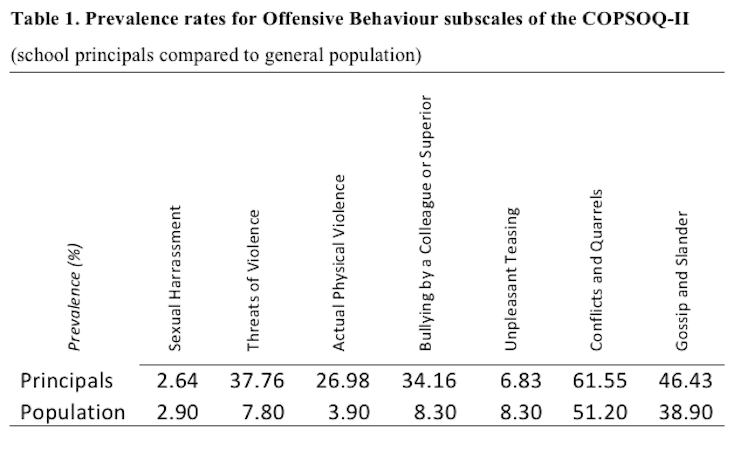School principals are five times more likely to face threats of violence than the general population, and seven times more likely to face physical violence, according to a new report released today.
The first independent study into the occupational health, safety and wellbeing of Australia’s school principals paints a pretty grim picture about the current work conditions for Australia’s school leadership.
The survey of 2,049 principals found that along with threats and acts of violence, school principals are also more likely to be bullied and are dealing with ever-increasing volumes of work and health problems due to stress.
The report found that these problems are reported in every state and territory and every school sector. It highlights a phenomenon that every minister and shadow minister of education across the country will need to grapple with.
So why is this happening? And more importantly, what can be done about it?
Too much pressure
Unfortunately to those working in schools and education research, the findings of this report may not come as much of a surprise. There is a looming crisis in school leadership in Australia that should not be underestimated.

The table above shows, in part at least, what school principals are increasingly having to deal with when they go to work.
The reasons for these conditions are complex but it’s true that with greater accountability measures, like NAPLAN testing for example, came unintended consequences. It sent a not-so-subtle message to parents that educators’ should be doing more for their children. This, in turn, fueled offensive behaviour by parents.
Those who see how much stress principals face are increasingly choosing not to apply for the top job. The Principals’ Australia Institute estimates that as many as 70% of Australia’s 10,000 school principals will reach retirement age within the next five years. There is up to an 80% reduction in “genuine” applications for principal vacancies (although this figure has been difficult to verify).
Principals and teachers deal daily with parents’ greatest hopes and deepest fears: the lives and potential futures of their children. Literacy and numeracy are now the proxy measures for the whole of school education. Tests such as NAPLAN are now clearly high stakes with funding and parent anxiety riding on the results.
Economists see this as unproblematic, even aspirational – you only have to look at Grattan Institute reports for example.
Recently the dean of education at Melbourne University Field Rickards presciently warned about the implications of eroding teacher trust. The high levels of offensive behaviour by adults reported in The Australian Principal Health and Wellbeing Survey confirm his warning.
Facing the crisis
But what can we do about it?
The report recommends several solutions designed to improve both working conditions for educators and learning conditions for students – the two should be seen as inseparable.
The first is the most urgent: the need to reduce the level of adult-to-adult bullying, threats and actual violence through the establishment of an independent task force with powers to interview all stakeholder groups, examine governance structures, information flow, and external influences on school functioning.
The task force should investigate each sector separately (i.e Government, Catholic, Independent) to determine differences in the occupational risk of the principal, and whether/how the risk also extends to teachers and students.
The report also highlights the benefits of professional support for all principals. Those who receive the least have the greatest challenges to maintain their mental health while those who cope best report the highest.
The consequences of this violence and intimidation in schools are likely to become costly for employer groups, through time lost to ill health, Occupational, Health and Safety (OH&S) claims against employers for not providing a safe working environment and reduced functioning at work. Setting up a task force now may prove to be the least expensive option in the long run.
Governments and employers will need to urgently exercise their responsibility to provide a safe work environment and improve the wellbeing of Australia’s school leaders. Failure to do so could conceivably result in a class action against them.

